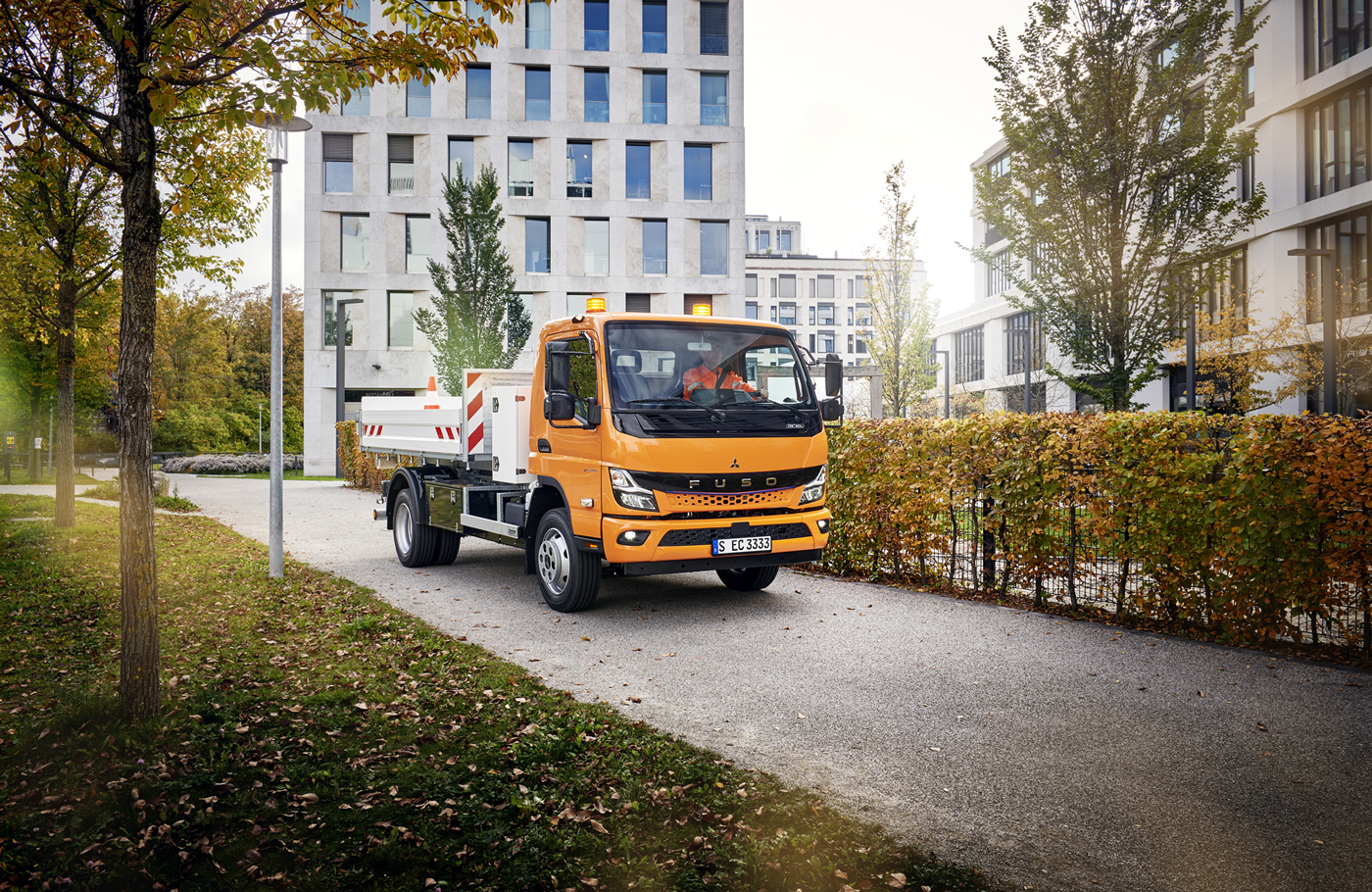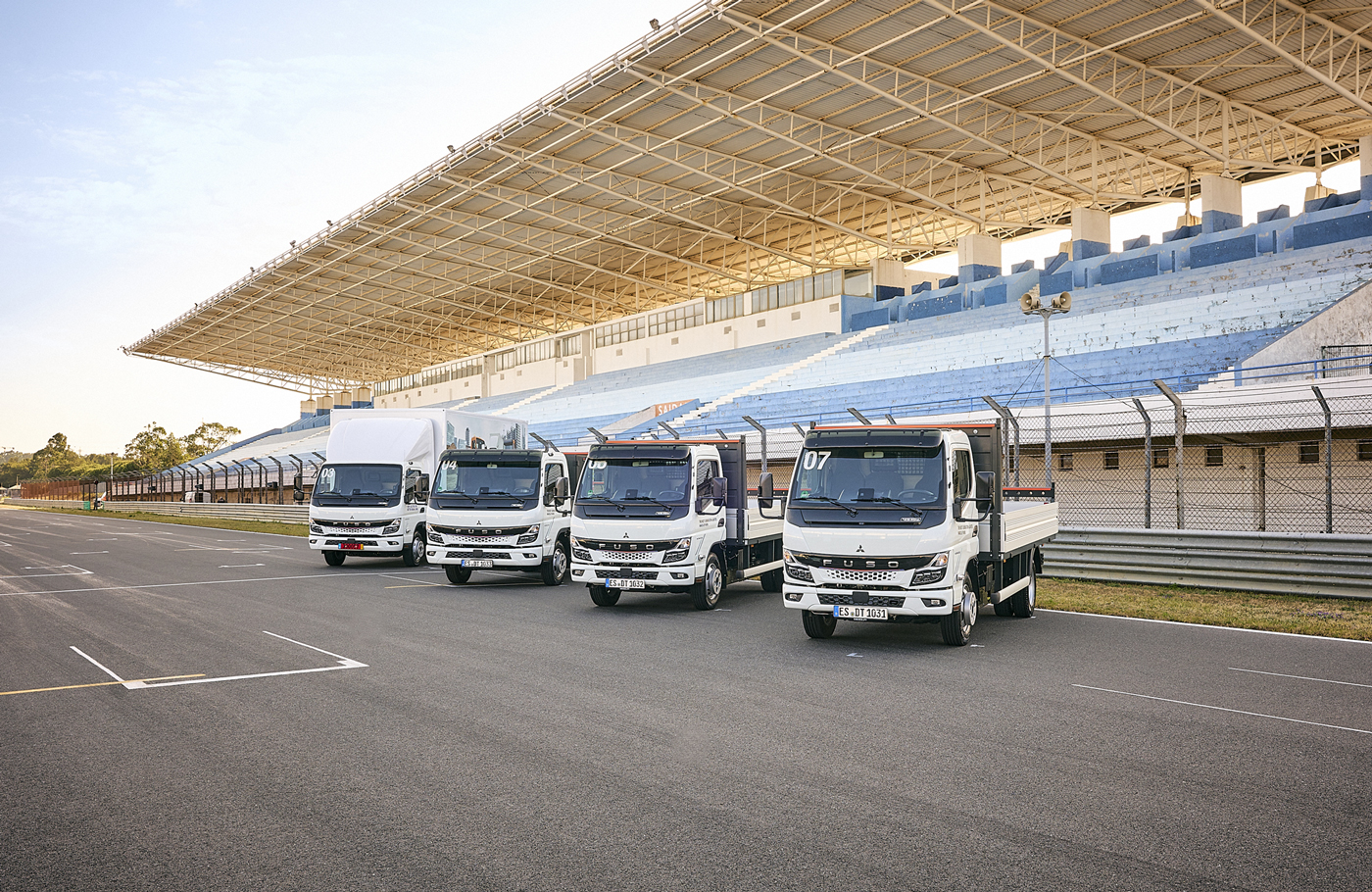Driven: Next Generation FUSO eCanter
Driven: Next Generation FUSO eCanter
Daimler Truck has launched the Next Generation FUSO eCanter. WILL SHIERS jetted to Portugal to drive it.
The zero-tailpipe-emission eCanter truck is built on the same line as its diesel-powered sibling at the Mitsubishi FUSO Truck Europe assembly plant in Tramagal, Portugal. Unlike the previous battery-powered eCanter, which was only offered as a 7.5-tonner, there are 42 derivatives of the latest incarnation from which to choose. This includes gross vehicle masses (GVMs) ranging from 4.25 to 8.55 tonnes, six different wheelbases from 2 500 to 4 750 mm, and two cab widths.
Power comes from a choice of two electric motors: either 110 kW for trucks in the 4.25- to six-tonne bracket, or 129 kW for 7.49- and 8.55-tonners.
The previous generation eCanter was powered by a single 81-kWh lithium-ion battery, which gave it a maximum range of 100 km. Buyers of the latest version, however, can choose from one (S), two (M), or three (L) 41.3-kWh lithium iron phosphate (LFP) batteries, giving maximum ranges of 70, 140, and 200 km respectively. With the help of Daimler Truck’s eTruck Ready tool, potential customers can determine how many batteries they require and spec their truck(s) accordingly.
The decision to opt for LFP batteries brings the eCanter in line with the rest of Daimler’s zero-tailpipe-emission truck offerings. With no nickel, cobalt, or magnesium content, it’s the more environmentally friendly option. LFPs also have a longer lifespan, require less maintenance, operate over a wider temperature range, and are quicker to charge.
The new eCanter supports both AC and DC charging, giving increased flexibility. Using DC current, charging from 20 to 80% takes approximately 24 minutes for single battery models (S), 26 minutes for two (M), and 39 minutes for three (L). AC charging takes between four and six hours, depending on the number of batteries fitted.


One of the downsides to LFP batteries is their size and weight, with each of the eCanter’s Chinese-manufactured battery packs weighing in at 450 kg. This includes the weight of the aluminium casing and the crash protection cradle in which they sit on the chassis.
Unlike its predecessor, the Next Generation eCanter benefits from an eAxle. Integrating the motor with the rear axle allows for a compact driveline, which is how FUSO has been able to produce so many different derivatives. The truck is also offered with a choice of mechanical PTOs.
FUSO says the new truck has been designed for a life of at least 10 years, but warranties are considerably shorter than this. Whereas a diesel-powered Canter is covered by a blanket three-year/200 000 km warranty, the eCanter’s warranty is more complicated. The high-voltage batteries are covered for six years/200 000 km, the electric driveline for five years/100 000 km, and the low-voltage batteries for three years/100 000 km.
Whereas the first eCanter was either rented or leased, this latest version will be backed by the full suite of Daimler Truck Financial Service funding options, in addition to being sold outright.
Order books are now open, and FUSO claims to have already received
1 000 advanced orders. This equates to 8% of all Canter production in the second half of 2023.
ON THE ROAD
“Driving electric trucks is fun,” says a FUSO spokesperson before handing us the keys to an eCanter 4C15E tipper and letting us loose on Portugal’s Circuito Estoril racetrack.
Climbing inside the 4.5-tonner, the first thing I notice is the heavily revised interior. It’s not only a vast improvement from the previous generation eCanter, but it looks and feels better than the current diesel-powered offering too. For starters, there’s a digital dashboard, compared with the regular Canter’s analogue version. Also exclusive to the eCanter is a multifunction steering wheel, which provides access to various information menus relating to the electric driveline.
The truck features a mechanically sprung ISRI driver’s seat, which allows the driver to dial in their weight. Although I do this accurately, I feel that I am still sitting too high; at six feet tall, I find myself staring directly at the tinted band along the top of the windscreen. It’s relatively easy to find a comfortable driving position and this is helped by a steering wheel that’s adjustable for both reach and rake. Internally adjustable mirrors would be a useful addition though.
Our test vehicle has the wider 2.1 m cab, which is roughly the same width as a Mercedes-Benz Sprinter. There’s plenty of space for two occupants, but a pair of people sharing the double passenger seat would definitely be cosy. Meanwhile, the new skinny cab is 1.7 m wide – more akin to the dimensions of a Smart car. Incredibly, this too can accommodate up to three adults. However, I reckon even Snow White and a couple of her co-workers would struggle to fit in comfortably!
Enter the cab with the new key fob in your pocket, and it’s a simple case of turning the steering column-mounted ignition switch to fire up the eCanter. On a cold day, you can pre-warm the truck’s single battery, so as not to waste any energy. The timer for this can be set on the truck’s digital dashboard (although an app is in development), but only works when the vehicle is on charge and the battery is at 100% capacity.
Other provisions for cold temperature operation are the heated seats, windscreen, and steering wheel. Drivers are encouraged to use these functions in lieu of the cab heater; together they than consume 0.6 kWh, as opposed to 6 kWh.
For our test drive, however, the sun is shining and I opt for open windows. The glass doesn’t completely disappear inside the door, but the windowsill is moulded to the same height, so it’s still relatively comfortable to rest your arm on.
The eCanter’s power is similar to its diesel-powered sibling, with the 4.25-tonne truck having the equivalent of 145 hp and larger trucks managing 173 hp. The difference, of course, is the torque, with all of it available from a standing start. With this in mind, it’s relatively easy to spin the rear wheels, so without driver training the rear tyres are likely to have short shelf lives.
The test drive is also a good chance to experiment with the regenerative braking. There are four modes in total, all of which are selected by moving the automatic gear selector forward or backward. B0 offers no retardation at all and is the equivalent of free-wheeling. B1 introduces slight resistance, while B2 (the default setting) is the equivalent of a diesel truck exhaust brake. B3 offers more powerful retardation and allows one-pedal driving. Modes B2 and B3 are both powerful enough to trigger the rear brake lights when in use.
On the test track’s mirror-like surface, the unladen eCanter’s ride is excellent. Take it onto public roads with potholes and manhole covers (which we do briefly), and it’s a different story. Although notably less choppy than its predecessor, the ride isn’t overly refined, and I find myself gripping the steering wheel for dear life after hitting a speed bump a bit too enthusiastically. In fact, I am surprised that it doesn’t trigger the crash sensor, which automatically shuts down power in the event of an accident. Apparently, it is possible to do this in extreme off-road conditions, but powering it back up is simple enough, and is covered by the extensive driver hand-over training.
Back on the track, I put the truck’s handling to the test in a 40 km/h slalom manoeuvre. The eCanter tackles this with far more poise than I had expected, presumably helped by the battery’s low centre of gravity. It also gives a reminder of how manoeuvrable the eCanter is, with its class-leading turning circle. I must confess that FUSO is indeed correct: driving an unladen eCanter on a test track really is a lot of fun.
Now, I’d like to put it through its paces in its correct environment – urban streets. If this brief experience behind the wheel is anything to go by, it’s likely to excel there too.
eCanter in SA
When will the eCanter come to South Africa? This could certainly happen relatively soon. “I’m happy to say the fully electric FUSO eCanter is currently in South Africa being prepared for operation in our customers’ fleets, as we continue to seek further performance feedback and establish readiness,” says Maretha Gerber, vice president: sales and marketing at Daimler Truck Southern Africa.
Published by
Will Shiers
focusmagsa








